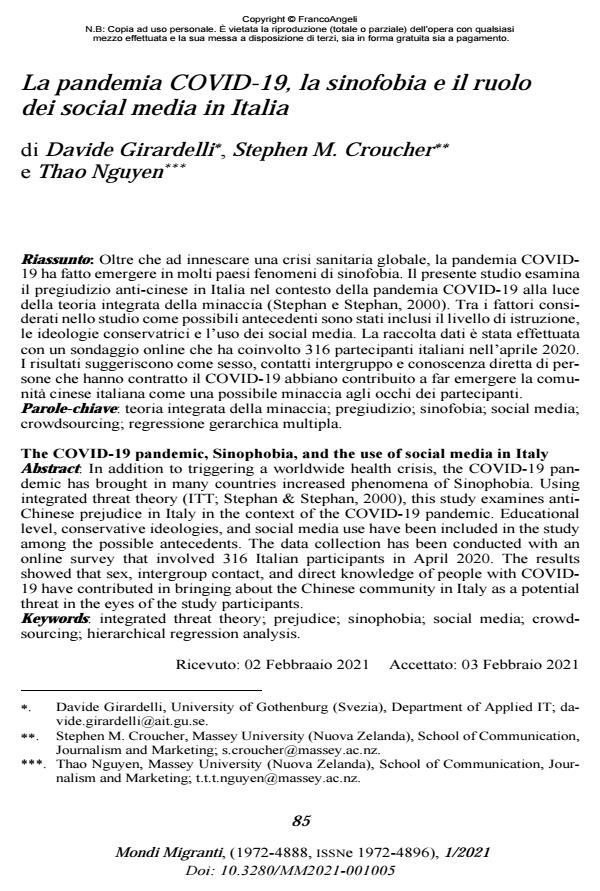La pandemia COVID-19, la sinofobia e il ruolo dei social media in Italia
Titolo Rivista MONDI MIGRANTI
Autori/Curatori Davide Girardelli, Stephen M. Croucher, Thao Nguyen
Anno di pubblicazione 2021 Fascicolo 2021/1
Lingua Italiano Numero pagine 20 P. 85-104 Dimensione file 254 KB
DOI 10.3280/MM2021-001005
Il DOI è il codice a barre della proprietà intellettuale: per saperne di più
clicca qui
Qui sotto puoi vedere in anteprima la prima pagina di questo articolo.
Se questo articolo ti interessa, lo puoi acquistare (e scaricare in formato pdf) seguendo le facili indicazioni per acquistare il download credit. Acquista Download Credits per scaricare questo Articolo in formato PDF

FrancoAngeli è membro della Publishers International Linking Association, Inc (PILA)associazione indipendente e non profit per facilitare (attraverso i servizi tecnologici implementati da CrossRef.org) l’accesso degli studiosi ai contenuti digitali nelle pubblicazioni professionali e scientifiche
Oltre che ad innescare una crisi sanitaria globale, la pandemia COVID-19 ha fatto emergere in molti paesi fenomeni di sinofobia. Il presente studio esamina il pregiu-dizio anti-cinese in Italia nel contesto della pandemia COVID-19 alla luce della teoria integrata della minaccia (Stephan e Stephan, 2000). Tra i fattori considerati nello studio come possibili antecedenti sono stati inclusi il livello di istruzione, le ideologie conservatrici e l’uso dei social media. La raccolta dati è stata effettuata con un sondaggio online che ha coinvolto 316 partecipanti italiani nell’aprile 2020. I risultati suggeriscono come sesso, contatti intergruppo e conoscenza diretta di persone che hanno contratto il COVID-19 abbiano contribuito a far emergere la comunità cinese italiana come una possibile minaccia agli occhi dei partecipanti.
Parole chiave:Teoria integrata della minaccia; pregiudizio; sinofobia; social me-dia; crowdsourcing; regressione gerarchica multipla.
- Pandémie en Italie : une analyse sur plusieurs niveaux Giuseppe Bettoni, in Hérodote /2021 pp.181
DOI: 10.3917/her.183.0181 - COVID-19 fear and ethnocentrism in the global south: A cross-cultural analysis Stephen M. Croucher, Doug Ashwell, Mohan Dutta, Jo Cullinane, Shawn Condon, Anthony Spencer, in International Journal of Intercultural Relations 102146/2025 pp.102146
DOI: 10.1016/j.ijintrel.2025.102146 - Gli atteggiamenti nei confronti dell'immigrazione prima e dopo la pandemia Covid-19 in 13 paesi europei. Uno studio esplicativo Veronica Riniolo, Vera Lomazzi, in MONDI MIGRANTI 1/2025 pp.189
DOI: 10.3280/MM2025-001010 - COVID-19 Prejudice Towards Afro-Brazilians Stephen Croucher, Thao Nguyen, Doug Ashwell, Anthony Spencer, Tatiana Permyakova, Oscar Gomez, in Journal of Intercultural Communication Research /2022 pp.383
DOI: 10.1080/17475759.2021.1957702 - Introduction: Migrants and Migration in the Eco-Pan-Syndemic Era Francesco Della Puppa, Fabio Perocco, in Two Homelands /2022
DOI: 10.3986/dd2022.2.01
Davide Girardelli, Stephen M. Croucher, Thao Nguyen, La pandemia COVID-19, la sinofobia e il ruolo dei social media in Italia in "MONDI MIGRANTI" 1/2021, pp 85-104, DOI: 10.3280/MM2021-001005